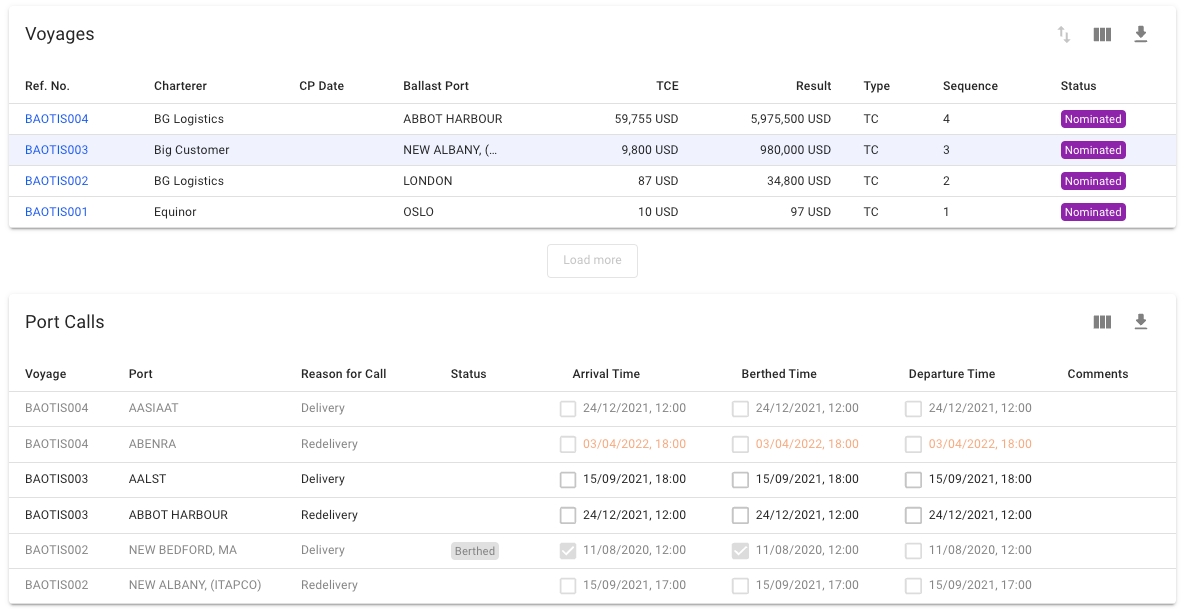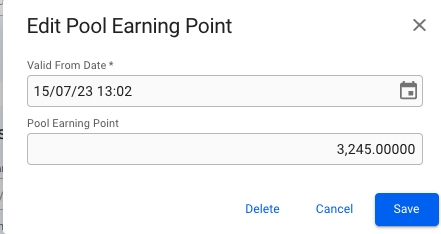
Loading...
Loading...
Loading...
Loading...
Loading...
Loading...
Loading...
Loading...
Loading...
Loading...
Loading...
Loading...
Loading...
Loading...
In the vessel drawer on the top right side there is a small map displaying the vessels last known position. This position is retrieved from AIS-positions for vessels which are subscribing to this feature, for vessels which are not subscribing the latest position is retrieved from the latest position report entered in the system. In addition to this you can now view the route from Dataloy Distance Table from previous port to next port displayed in the same map. The route is the green line in the map.
In the "Voyages & Port Calls" section of the vessel drawer, you will find the most important information about a vessel and its voyages.
The "Vessel Details" section shows data about the vessel such as DWT summer/tropical and draft. Click Expandto show contact information for the vessel.
This is a list of voyages on the opened vessel sorted by newest first. If there is an ongoing voyage in the list, it is indicated with a blue marker on the left side, and it's Port Calls are shown in the list below.
When clicking the reference number of the voyage, the voyage drawer will open. If the voyage does not have a reference number, a text value displaying 'Missing' will show instead. This is also clickable and will open the selected voyage.
Clicking on the voyages, except from the voyage Ref. No, will list all port calls of the selected voyage, as well as the next and previous voyage below. The next and the previous voyages' port calls will be a lighter text color to make them separable. Clicking on port calls in the list opens the corresponding port call's drawer where you can make changes.
The re-sequence feature enables reordering the list of voyages assigned to a vessel (see Figure 1). To utilize the feature, click Vessels, select the one that requires reordering, and click the Two-way arrow icon in the newly appeared window on the right.
The user can now drag and drop the voyages to re-order them in the desired order. For example, Figure 2 illustrates Item 77, which is being dragged down. It is expected that the item will have replaced Item 76 after release.
Next, the result after the aforementioned release is presented in Figure 3.
Any voyages that will have their sequence number changed, will have their previous old sequence number parenthesized.
The Save button updates Fleet Plan Voyages and saves the new appearance of the Voyage List.
Port calls can also be resequenced to a different position within the previous, current, or next voyage. To resequence a port call, click the resequence symbol in the top right corner of the port calls list. A popup modal will then show and the port call can be dragged and dropped in the desired position (Figure 4). Note that only one port call can be moved at a time. Also, only port calls after the last Arrived, Berthed or Departed port call can be moved in the list.
Open the Vessels module in the Core menu in the top left corner.
Find your selected vessel.
Vessel "Speed and Consumption" data can be accessed in the top tab menu. Details can be maintained directly in the fields or from the table actions.
Open the Vessels module in the Core menu in the top left corner.
Click Create Vessel in the top right corner.
Fill in all required fields listed below in the Create Vessel window.
Required fields:
Vessel Name
Vessel Type
Vessel Code*
*The Vessel Code field is only visible and required if you have ticked off the "Set vessel code" checkbox. If the checkbox is not ticked off, a Vessel Code will automatically be generated for you.
To add a Bunker Type to a vessel, navigate to the Speed and Consumption section of the Vessel drawer.
In the Bunker Types table in the bottom of the drawer, click Add Bunker Type and fill in the fields.
To delete a bunker type, simply click on it in the Bunker Types list, and click the Delete button.
The Load and Discharge rates section is an an overview of the load and discharge rates applicable for ports and terminals. It must not be mixed with the vessels' max load and discharge rates.
Open the Vessels module.
Open the vessel drawer
Vessel "Load & Discharge Rates" data can be accessed in the top tab menu. Details can be maintained directly from the table actions.
To add a Main Engine Speed to a vessel, navigate to the Speed and Consumption section of the Vessel drawer.
In the Main Engine table, click Add Main Engine Speed and fill in the fields.
You can add multiple speed and consumption data, for example one speed order for full speed and one for eco speed.
An entry to the speed and consumption list may be the default laden and default ballast speed, but the Vessel may only have one of each.
To manage load and discharge rates on a vessel for selected ports and terminals, navigate to the Load and Discharge Rate section of the Vessel drawer. Use the table in the tab to edit, delete or add a new rate.
Click on a row to edit and use the modal to make changes.
Open the Vessels module in the Master Data section.
Open the Vessel drawer
Vessel "Internal Data" can be accessed in the top tab menu.
For "old" vessels that you have in the system that has a minimum of one commenced voyage, the internal data should already be established. For new vessels or vessels without commenced voyages, open the action menuin the top right and choose "Create Internal Data" as indicated below.
Vessels created after version 6.27 will have Internal Data generated automatically.
Vessels copied after version 6.29 will have Internal Data generated automatically.
When the above 'Create Internal Data' is created, it will be possible to access the below Internal Data page:
Miscellaneous:
Here, you can set fields like Company and Business Unit, Bank Account Receivable, Master Account and Pool, as well as the Pool Earning Points. In this table, you are able to create, edit and delete a Pool Earning Point:
Create/edit modal for Pool Earning Point.
Open the Vessels module in the Master Data section.
Open the vessel drawer
Vessel "AIS Data and Weather Report" data can be accessed in the top tab menu.
For the tab to be enabled an AIS position has to be available.
How to enable or disable AIS-subscription
You can enable or disable the subscription to AIS-positions for a vessel.
Open the Vessels module in the Master Data section.
Open the vessel drawer
If the vessel has an IMO-number, click on the icon in the top right.
A light grey icon indicates that the vessel has no IMO-number registered. A dark grey icon indicates that it is not subscribing to AIS-positions. A blue icon indicates that the vessel is subscribing to AIS-positions.
In the table, click Add icon and fill in the fields
Use the checkboxes to select the rows to delete. Click Delete iconand confirm.
To copy any vessel, open the Vessel drawer and click the More button in the top right to bring up the menu.
Clicking Copy Vessel will open a Copy Vessel modal where you are prompted to enter a new name for the new copy.
When you click Create, the data from the original Vessel will be copied over to the new Vessel, with a few exceptions.
Voyages and Port Calls will not be copied to the new Vessel.
IMO Number will not be copied to the new Vessel.
The internal data of the copied vessel will be given default values for some fields like company, business unit, vessel code and vessel class.
The vessel code will be set to the unique key value for the Vessel, used by the API.
Pool and Pool Earning Points will not be copied to the new Vessel.
Depending on your access permissions the list of Vessels might not be visible.
Open the Vessels module in the Core Menu list on the top left corner.
There are several sorting and filtering options available for you to narrow down what you include in the list view, including a "My Vessels" filter that shows all the vessels of which the logged-in user is set as one of the following:
Master User
Responsible Accountant
Operator
Claims Operator
You can also Customise the columns of the Vessels list to add, reorder or hide columns. The columns Operator, Built, and Schedulable are hidden by default.
On top of the list, you may find three tabs: Operative, Archived, and Map. The two first tabs illustrate pre-sorted data based on the fleet exit date parameter. The Map includes an interactive map with the current vessels' location.
Moreover, filters found on the same line as the tabs, apply to both tables. If you switch between tabs, the filters will remain the same, facilitating navigation.
A click on the Operative tab will load a table, that contains only operable vessels. In other words, the vessels whose fleet exit date is either not set, or set in the future.
On the other hand, the Archived tab presents vessels whose fleet exit date is older than the current date (fleet exit date was in the past).





















